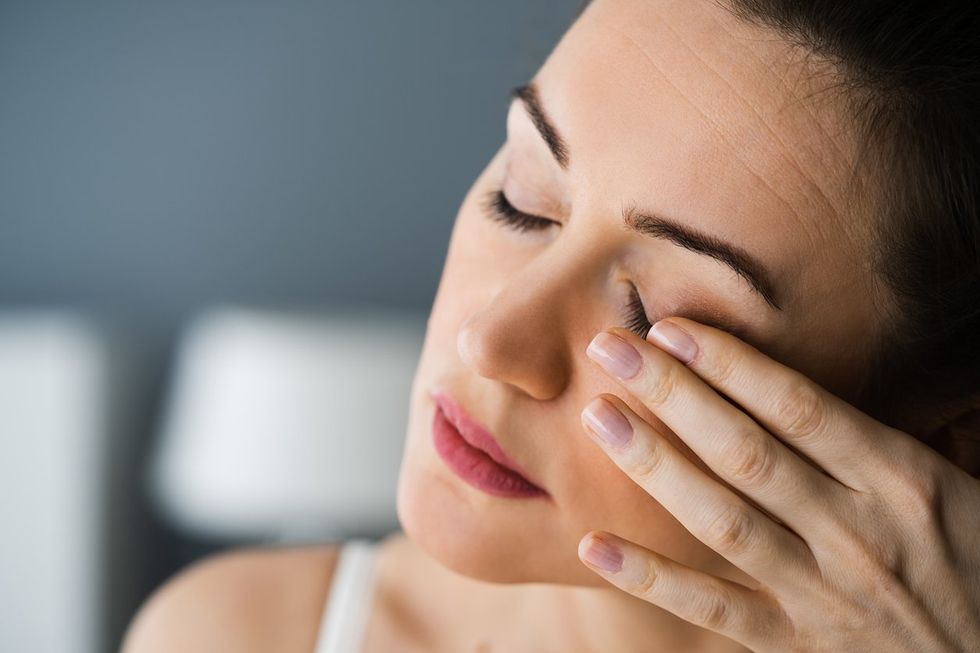
July is Dry Eye Awareness Month.
Blink twice if you’re reading this. How do your eyes feel?
Are they irritated? Do you feel like you have grains of sand in your eyes but you’re nowhere near the beach? Do you have an autoimmune disease?
That last question may seem random, but having an autoimmune disease puts you at higher risk for dry eye disease — a chronic condition that causes symptoms like grainy eyes and loss of vision if not treated.
“If you have dry eye that persists and it’s not just episodic, get in to see an ophthalmologist. And that’s important especially if you have a family history [of autoimmune disease] or you have other systemic problems,” said Mina Massaro, M.D., a professor of clinical ophthalmology at the Scheie Eye Institute and upcoming director of dry eye services at NYU Langone Health.
It’s also important for women and people assigned female at birth (AFAB) to note the connection between autoimmune disease and dry eye disease, since both conditions are more common in women than men.
Read: What You Need to Know About Dry Eye Disease >>
What is dry eye disease?
Dry eye disease is a disorder that affects the tear film, which helps protect and moisturize your eyes.
There are two main types of dry eye disease:
- Aqueous-deficient: Your eyes don’t produce enough tears to keep your eyes moisturized
- Evaporative: Your eyes make enough tears, but the fluid doesn’t stick around long enough and dries out quickly
Symptoms of dry eye disease can range from redness and grittiness to blurred vision, eye pain and changes in eyesight. Without treatment, dry eye disease can seriously impact your vision and quality of life.
The relationship between autoimmune disease and dry eye disease
Autoimmune diseases happen when the body’s immune system mistakenly attacks healthy organs, cells and tissues. And that can include the tear glands, which causes a decrease in tear production and leads to inflammation and damage on the surface of the eye.
Chronic eye inflammation also affects the oil glands, and without oil, your tears evaporate too soon.
Together, reduced tears, lack of oil and the presence of inflammation can all lead to dry eye disease, a condition that gets worse over time without treatment.
Read: Inflammation 101 >>
Common autoimmune diseases related to dry eye disease
“There are various autoimmune conditions that attack or create inflammation in glands and tissues that are responsible for creating tears,” Massaro said.
Common autoimmune diseases associated with dry eye disease can include:
- Diabetes: High blood sugar levels, the hallmark of diabetes, can trigger inflammatory responses that affect tear production and speed up tear evaporation. Over time, high blood sugar can also damage nerves in the eye, which can lead to decreased quantity and quality tears.
- Rheumatoid arthritis: The immune cells that target the joints in people with rheumatoid arthritis can also target eye glands and tissues.
- Lupus: About 1 in 5 people with lupus, a systemic disease that causes inflammation in different parts of the body, also have dry eye disease.
- Graves’ disease: The condition can harm the muscles and glands in the eye and alter the tear film, which may also cause surface damage.
Treatment for dry eye disease
“All the autoimmune conditions will somehow affect the lacrimal gland [located in the eye], so the treatment for most cases will be similar,” Massaro said. “We’ll put patients on anti-inflammatory drops; we will put them on lubricating drops — and this goes for pretty much all the autoimmune conditions.”
In addition to eye drops, eye care providers may use prescription treatments that increase tear production or medical devices involving light or heat to help treat symptoms and lubricate eyes. Silicone plugs can help keep tears on the eyes for a longer period of time. “Sometimes we can prescribe specialized contact lenses on the surface of the eyes to prevent evaporation,” Massaro said.
There are also lifestyle changes that can help ease symptoms of dry eye disease. These include:
- Wearing wrap-around sunglasses when outdoors
- Avoiding air conditioning vents indoors and in the car
- Avoiding places where people smoke and/or quitting smoking
- Limiting screen time
- Scheduling breaks if you work in front of a computer
- Using a humidifier in your home to keep the air from getting too dry
Clear communication is key
Autoimmune diseases are complex and often require different treatments and medications — and some of those medications can make symptoms of dry eye disease worse. That’s why it’s important to keep your healthcare providers — including your eye care provider — in the loop regarding your treatment plans and any changes in your vision.
“The collaboration is critical, and the communication is critical,” Massaro said.
When it comes to living with dry eye disease and autoimmune disease, there’s no “I” in team.
This educational resource was created with support from Viatris, a HealthyWomen Corporate Advisory Council member.
From Your Site Articles
Related Articles Around the Web

